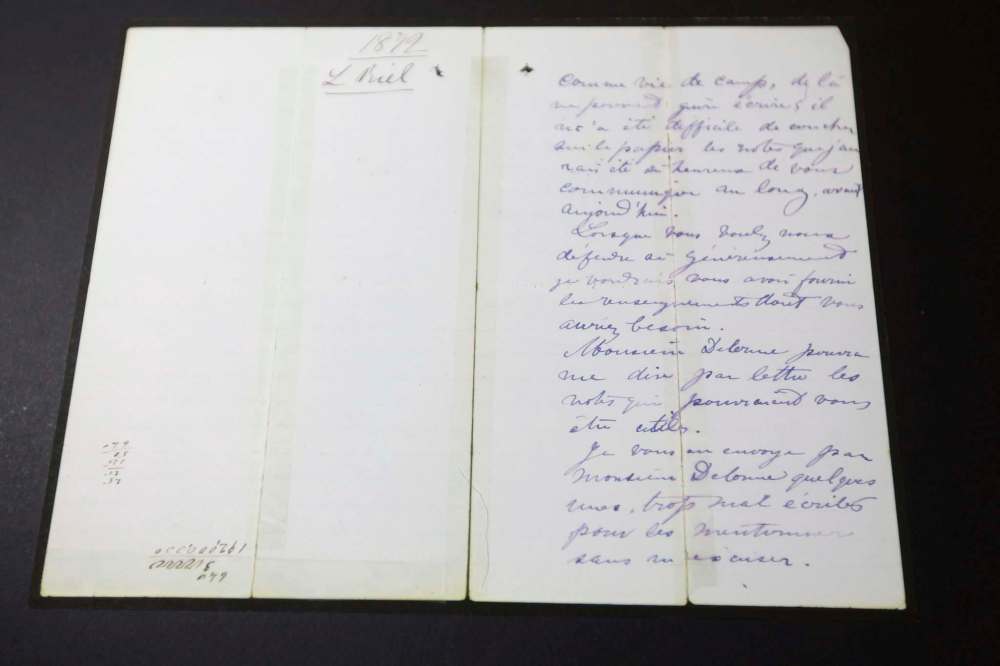In a wired world, handwriting grabs our attention
Advertisement
Read this article for free:
or
Already have an account? Log in here »
To continue reading, please subscribe:
Monthly Digital Subscription
$0 for the first 4 weeks*
- Enjoy unlimited reading on winnipegfreepress.com
- Read the E-Edition, our digital replica newspaper
- Access News Break, our award-winning app
- Play interactive puzzles
*No charge for 4 weeks then price increases to the regular rate of $19.00 plus GST every four weeks. Offer available to new and qualified returning subscribers only. Cancel any time.
Monthly Digital Subscription
$4.75/week*
- Enjoy unlimited reading on winnipegfreepress.com
- Read the E-Edition, our digital replica newspaper
- Access News Break, our award-winning app
- Play interactive puzzles
*Billed as $19 plus GST every four weeks. Cancel any time.
To continue reading, please subscribe:
Add Free Press access to your Brandon Sun subscription for only an additional
$1 for the first 4 weeks*
*Your next subscription payment will increase by $1.00 and you will be charged $16.99 plus GST for four weeks. After four weeks, your payment will increase to $23.99 plus GST every four weeks.
Read unlimited articles for free today:
or
Already have an account? Log in here »
Hey there, time traveller!
This article was published 15/09/2018 (2625 days ago), so information in it may no longer be current.
In the daily barrage of emails and texts, a handwritten letter stands out like a gem amid gravel.
It’s rare these days to receive a note or letter with our name penned on the outside of the envelope, southwest of the stamp. It’s instantly compelling, because handwriting signifies the writer cares enough to invest time in a method of communication that is intimately personal.
Yes, it’s easier and faster to communicate digitally. But to connect in a way that is distinctive and memorable, resurrect the tradition of pen on paper.

This small pleasure was delivered to several of us at the Free Press recently. A newsroom intern named Maggie Macintosh gave handwritten thank-you notes to editors who worked closely with her before she returned to her final year of journalism studies in Toronto.
She must have bought the paper and envelopes at a stationery store, if stationery stores still exist, because the card and envelopes matched and were made of thick stock, the type of paper you rub between your thumb and forefinger because it feels luxurious.
As an added element, she formed the words “Thank you” on the outside of the envelopes by clipping individual headline letters from the newspaper and gluing them on, almost like a kidnapper’s ransom note. Using headline type was a surefire way to get a grin from newspaper editors.
The trouble it took to compose her creative effort made her thanks seem authentic. It cost her something, and it meant something.
Macintosh, who is in her early 20s, is too young to have known the time before cursive was made almost obsolete by electronic communication. But she’s smart enough to know the impact of handwritten missives.
Part of the appeal of handwriting is that it displays the unique personality of the writer. It’s as unique as our fingerprints. There used to be experts who studied handwriting and claimed the characteristics of cursive revealed insights into the writer’s personality. But, today, there is scant employment for such experts in an age when the vast majority of writing is in digital type.
The personalities displayed by handwriting are evident when we read the penmanship of prominent people from the past.
The University of Manitoba archives has a letter written by Louis Riel. His handwriting is distinctive, with the initial letters of his sentences crafted with flamboyant flair, as befit his personality. The realization that the letter is on paper that was held by Riel offers a direct connection — his hand to our eye — that transcends the 135 years since he dipped his pen in an ink pot.
Wise salespeople know the power of handwriting to make a memorable impression. After our family bought a car from a Winnipeg dealership, the salesman mailed annual handwritten notes to our home. If his purpose was to make himself top of mind when we need to buy another vehicle, it worked. He’s the only car salesman whose name we know.
Handwritten sentiments are particularly appreciated to mark family-life milestones, such as weddings and funerals. Hallmark cards are eloquent, but impersonal. Most people would rather receive longhand messages that reflect innermost sincerity and an individual connection.
While I have never offered romantic advice in a newspaper column, gladly leaving matters of the heart to Free Press advice columnist Maureen Scurfield, I will hazard to make an exception in the case of written declarations of amorous inclination.
Love letters should always be written by hand. Always. The initial confession of our endearment should never be expressed in the cold type of an email or, even worse, a text.
Our love letter may be the most important written communication our sweetheart ever receives. It will likely be saved in a dresser drawer or shoebox, and often reread.
A wonderful result of delivering handwritten notes and letters is that people who receive them tend to write back. Send some, get some.
It means our home mailbox may occasionally contain at item more exciting than the usual array of bills, form letters and advertising flyers.
Routine days get more interesting when we peer into our mailbox and see our name on a hand-addressed envelope. It took time and trouble for the correspondent to write longhand, which means it’s from someone who values our relationship.
Perhaps it’s the target of our affection, responding to our love letter with handwritten sentiments of their own.
Carl DeGurse is a member of the Free Press editorial board.



